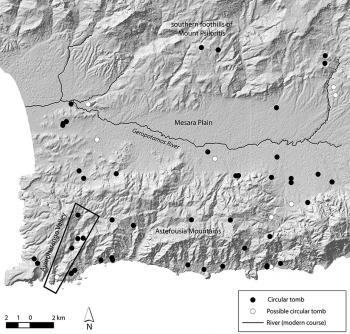American Journal of Archaeology | The Journal of the Archaeological Institute of America
You are here
Communication Networks, Interactions, and Social Negotiation in Prepalatial South-Central Crete
January 2017 (121.1)
Article
Communication Networks, Interactions, and Social Negotiation in Prepalatial South-Central Crete
Circular tombs are our best source of information regarding life and death in Prepalatial south-central Crete (3100–1900 B.C.E.). This article considers the phenomenon of movement in that area to shed new light on interactions among the communities that constructed and used such tombs. It employs GIS and builds on the recently developed focal mobility network procedure to gain insights into patterns of movement in south-central Crete. The results of the GIS analyses emphasize that circular tombs were as a rule constructed near optimal paths. Nevertheless, the spatial pattern testifies to synchronic and diachronic variations, which, examined in the light of the distribution of non-Cretan grave goods, support the conclusion of previous research that different social strategies underlay the appearance and adoption of this burial type throughout the study area. Even though the wide distribution of circular tombs across south-central Crete points to some kind of shared cultural values, the process of diffusion was clearly far from homogeneous.
More articles like this:
Communication Networks, Interactions, and Social Negotiation in Prepalatial South-Central Crete
By Sylviane Déderix
American Journal of Archaeology Vol. 121, No. 1 (January 2017), pp. 5–37
DOI: 10.3764/aja.121.1.0005
© 2017 Archaeological Institute of America
Archive
2020s
2024 (Vol. 128)
2023 (Vol. 127)
2022 (Vol. 126)
2021 (Vol. 125)
2020 (Vol. 124)
2010s
2019 (Vol. 123)
2018 (Vol. 122)
2017 (Vol. 121)
2016 (Vol. 120)
2015 (Vol. 119)
2014 (Vol. 118)
2013 (Vol. 117)
2012 (Vol. 116)
2011 (Vol. 115)
2010 (Vol. 114)
2000s
2009 (Vol. 113)
2008 (Vol. 112)
2007 (Vol. 111)
2006 (Vol. 110)
2005 (Vol. 109)
2004 (Vol. 108)
2003 (Vol. 107)
2002 (Vol. 106)
2001 (Vol. 105)
2000 (Vol. 104)
1990s
1999 (Vol. 103)
1998 (Vol. 102)
1997 (Vol. 101)
1996 (Vol. 100)
1995 (Vol. 99)
1994 (Vol. 98)
1993 (Vol. 97)
1992 (Vol. 96)
1991 (Vol. 95)
1990 (Vol. 94)
1980s
1989 (vol. 93)
1988 (vol. 92)
1987 (vol. 91)
1986 (vol. 90)
1985 (Vol. 89)
1984 (Vol. 88)
1983 (Vol. 87)
1982 (Vol. 86)
1981 (Vol. 85)
1980 (Vol. 84)
1970s
1979 (Vol. 83)
1978 (Vol. 82)
1977 (Vol. 81)
1976 (Vol. 80)
1975 (Vol. 79)
1974 (Vol. 78)
1973 (Vol. 77)
1972 (Vol. 76)
1971 (Vol. 75)
1970 (Vol. 74)
1960s
1969 (Vol. 73)
1968 (Vol. 72)
1967 (Vol. 71)
1966 (Vol. 70)
1965 (Vol. 69)
1964 (Vol. 68)
1963 (Vol. 67)
1962 (Vol. 66)
1961 (Vol. 65)
1960 (Vol. 64)
1950s
1959 (Vol. 63)
1958 (Vol. 62)
1957 (Vol. 61)
1956 (Vol. 60)
1955 (Vol. 59)
1954 (Vol. 58)
1953 (Vol. 57)
1952 (Vol. 56)
1951 (Vol. 55)
1950 (Vol. 54)
1940s
1949 (Vol. 53)
1948 (Vol. 52)
1947 (Vol. 51)
1946 (Vol. 50)
1945 (Vol. 49)
1944 (Vol. 48)
1943 (Vol. 47)
1942 (Vol. 46)
1941 (Vol. 45)
1940 (Vol. 44)
1930s
1939 (Vol. 43)
1938 (Vol. 42)
1937 (Vol. 41)
1936 (Vol. 40)
1935 (Vol. 39)
1934 (Vol. 38)
1933 (Vol. 37)
1932 (Vol. 36)
1931 (Vol. 35)
1930 (Vol. 34)
1920s
1929 (Vol. 33)
1928 (Vol. 32)
1927 (Vol. 31)
1926 (Vol. 30)
1925 (Vol. 29)
1924 (Vol. 28)
1923 (Vol. 27)
1922 (Vol. 26)
1921 (Vol. 25)
1920 (Vol. 24)
1910s
1919 (Vol. 23)
1918 (Vol. 22)
1917 (Vol. 21)
1916 (Vol. 20)
1915 (Vol. 19)
1914 (Vol. 18)
1913 (Vol. 17)
1912 (Vol. 16)
1911 (Vol. 15)
1910 (Vol. 14)
1900s
1909 (Vol. 13)
1908 (Vol. 12)
1907 (Vol. 11)
1906 (Vol. 10)
1905 (Vol. 9)
1904 (Vol. 8)
1903 (Vol. 7)
1902 (Vol. 6)
1901 (Vol. 5)
1900 (Vol. 4)
1890s
1899 (Vol. 3)
1898 (Vol. 2)
1897 (Vol. 1)
1896 (Ser. 1, Vol. 11)
1895 (Ser. 1, Vol. 10)
1894 (Ser. 1, Vol. 9)
1893 (Ser. 1, Vol. 8)
1891 (Ser. 1, Vol. 7)
1890 (Ser. 1, Vol. 6)
1880s


